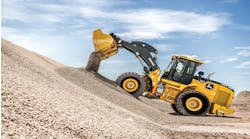Briggs & Stratton, a Milwaukee-based manufacturer of engines works hard to maintain a reputation for producing world-class products. With some products, its own production team can provide all the expertise it requires. But in other areas, it recognizes it is best to partner with other organizations, and the company spared no expense to find the best manufacturing partners in the world.
As Briggs & Stratton's vice president of corporate marketing Bill Reitman explains, back in the 1980s the Briggs & Stratton leadership realized it was a very good, high-volume, high-value producer, but that it needed a partner to help it reach a higher level of professional expertise in the heavy-duty, lower-volume, higher performance end of the engine spectrum.
It found such a partnership with Japanese manufacturer Daihatsu, a member of the Toyota group. The relationship, which began in the late 1980s and has since produced an impressive portfolio of engine products, is really coming into its own now as Briggs & Stratton prepares to introduce a wide variety of new products. Daihatsu had great manufacturing expertise, while Briggs & Stratton excelled in engine design and distribution, and the synergy between the companies further added to their relationship.
The first product was the V-twin engine with Daihatsu, which became a Daihatsu and Briggs & Stratton joint venture. Briggs & Stratton also developed a strong relationship with Mitsubishi. In addition to manufacturing synergies, the companies developed parts-sourcing relationships and Briggs & Stratton manufactured parts for their Japanese partners as well as sourcing parts.
“Our Japanese partners have an absolute passion for attention to detail when it comes to quality, and testing for perfection,” says Reitman. “Any worker online can stop production if they see anything that is less than perfect. Our Briggs & Stratton plants are high volume, but we didn't have a commercial-focused engine plant. As the quality of the engine ratchets up, so must the attention to quality control and the sophistication of the manufacturing process, which requires tighter tolerances and more rigorous testing procedures under more stringent conditions, which our Japanese partners have developed on extremely high levels. It's a great relationship because we have learned and benefited from their manufacturing capability and we have been able to provide some assistance to them as we source parts anywhere on the globe.”
Known for years as a specialist in the lawn-and-garden engine segment, Briggs & Stratton is taking a big step into the construction end with its new Big Block series of air-cooled and liquid-cooled engines. These V-twin engines, available in 25, 27, 29, 31, 33 and 35 horsepower air-cooled and liquid-cooled, are the latest designs resulting from the Daihatsu Briggs & Stratton joint venture, combining Briggs & Stratton commercial power experience in aluminum block engine design with Daihatsu Motor Co.'s commercial design and manufacturing expertise. Manufactured at DBS' Kagami, Japan, facility, the engines are a major step forward into the commercial construction market for Briggs & Stratton.
“As the market becomes more competitive, you have to be able to offer the whole line-up”, says Phil Cappitelli, Briggs & Stratton's vice president of the Vanguard line. “We were strong in the 14 to 23 horsepower categories, so to add to our product offering, we decided to go up in horsepower.”
The Big Block series features aluminum block air- and liquid-cooled V-twin engines. “They are less expensive than cast-iron engines, which may be more durable, but you have to look at the equipment they power,” says Cappitelli. “By the time the engine wears out, the equipment is tired and worn. So the cast-iron may be more than the equipment needs. Aluminum can still last the lifetime of the equipment and cost 20 to 50 percent less than cast iron.”
Cappitelli says for commercial-cutting or any debris-laden application, the air cleaner on the big block engines is commercial grade. “Along with the new air cleaner, we have a steel rotating screen, which does a better job of chopping up debris that comes into the air intake,” he says. “The molded blower housing keeps air from leaking in, with molded lips over the edge, which also keeps out 80 percent of the debris that would filter in between the blower and the housing. We developed this in response to customer requests. It enables the heat to be distributed better, allowing the engine to run cooler and longer. We call the panel, the air cleaner and the blower-housing design an advanced debris-management system.”
The Big Block engines also feature:
- V-twin/overhead valve technology, which can minimize wear and tear on components and equipment;
- innovative intake and exhaust system, to provide a quieter engine;
- cast-iron cylinder sleeves, which increases durability and improves oil control;
- steel-backed aluminum bearings, to increase load capacity and reduce engine noise;
- 5-inch centrifugal, multi-stage industrial air cleaner, to provide maximum engine protection.
Briggs & Stratton's new three-cylinder engine line, ranging from 17 to 34 horsepower, which comes from a Briggs & Stratton and Daihatsu manufacturing and marketing relationship, should appeal to manufacturers, Reitman adds, because they allow the manufacturer to offer a range of gas- and diesel-powered products without significant change between power platforms.





